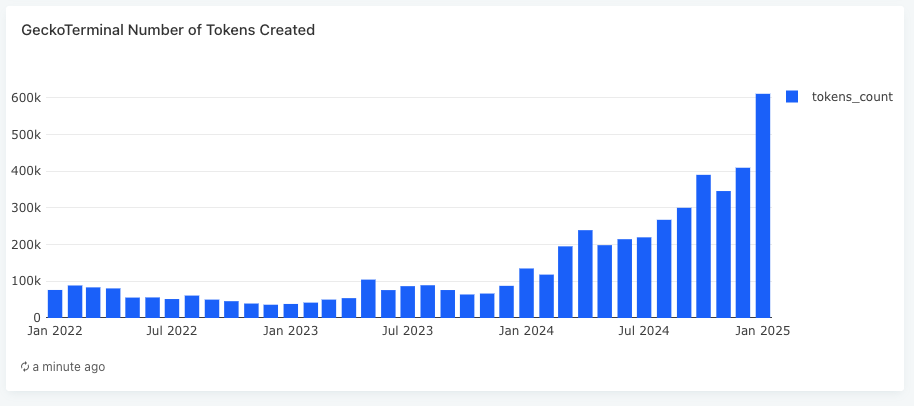
Over 600,000 New Tokens Launched in January, Raising Liquidity Concerns
January saw a dramatic surge in the creation of new tokens, with more than 600,000 tokens launched across various blockchain networks. This unprecedented increase in token creation has raised significant concerns about liquidity and the long-term sustainability of the broader cryptocurrency market. Experts worry that the flood of new tokens could dilute the value of existing assets and create challenges for investors seeking to navigate an increasingly crowded market.
The Explosion of New Tokens
The rise in new token launches in January is part of a broader trend in the cryptocurrency industry where more projects are leveraging blockchain technology to create digital assets. These tokens can serve various purposes, from representing utility within a specific ecosystem to acting as speculative investment vehicles. However, the sheer volume of new tokens has raised alarms about the potential consequences for market liquidity.
One major factor contributing to the surge in token creation is the ease with which developers can issue new assets. Many blockchain networks, such as Ethereum, Binance Smart Chain, and others, offer relatively simple ways for developers to create and deploy tokens using standardized smart contract templates. While this democratizes access to blockchain technology, it also makes it easier for low-quality or even fraudulent projects to flood the market.
Liquidity Concerns and Market Implications

As the number of tokens increases, so too does the risk of liquidity problems. Liquidity refers to the ability to buy or sell an asset without significantly affecting its price. With over 600,000 new tokens entering the market in a single month, liquidity could become strained as investors spread their capital across an overwhelming number of assets.
The sudden proliferation of tokens can result in smaller and less liquid tokens struggling to maintain value, as there is insufficient demand or trading volume. This is particularly concerning for retail investors who may be drawn to the hype around new tokens but find it difficult to exit their positions when the market turns unfavorable. As more tokens flood exchanges, the liquidity of well-established assets like Bitcoin and Ethereum could also be affected, as investor capital is diverted to new, untested tokens.
The Impact on Speculation and Investor Behavior
Many of the new tokens launched in January are part of speculative projects aiming to capitalize on the market’s enthusiasm for digital assets. These speculative tokens often promise high returns but lack substantial utility or a clear long-term vision. The influx of these types of tokens has created an environment where investors are increasingly exposed to risky ventures, with the potential for significant losses.
While some of these tokens may see short-term gains, the lack of a solid foundation or real-world use case could lead to rapid crashes, as investors realize that many of these tokens are little more than speculative vehicles. This type of market behavior could contribute to increased volatility, making it more difficult for both individual and institutional investors to make informed decisions.
Regulatory and Ethical Concerns
The rapid creation of new tokens also raises regulatory and ethical concerns. In many cases, the flood of new tokens has outpaced the ability of regulators to ensure investor protection. Some of the tokens launched in January may not comply with existing securities laws, and their promoters could be engaging in practices like market manipulation or misleading advertising.
Regulatory bodies around the world are already beginning to scrutinize the crypto market more closely, and this surge in token launches could prompt further intervention. Governments may introduce new regulations to protect investors from the risks associated with the excessive creation of tokens and the potential for fraud.
The Path Forward
Despite the challenges posed by the surge in new token launches, there are potential solutions to address liquidity concerns. One approach could be for platforms to implement stricter vetting processes for token listings, ensuring that only projects with real utility and long-term viability are allowed to enter the market. Additionally, increased education and transparency for investors can help mitigate the risks associated with speculative tokens.
The cryptocurrency industry must also focus on fostering innovation that provides real-world value rather than simply launching tokens for the sake of hype. As the market matures, projects that focus on solving tangible problems are more likely to succeed and maintain liquidity over time.
Conclusion
The launch of over 600,000 new tokens in January has raised significant concerns about liquidity and market stability in the cryptocurrency ecosystem. While the ease of creating new tokens has democratized access to blockchain technology, it has also created challenges for investors and regulators. As the market continues to evolve, ensuring that only high-quality, sustainable projects thrive will be crucial in maintaining liquidity and stability in the crypto space.